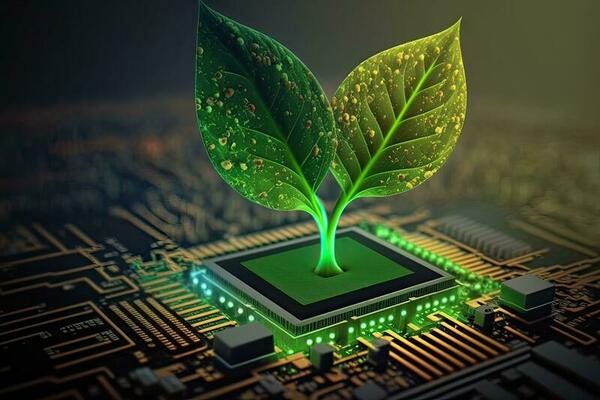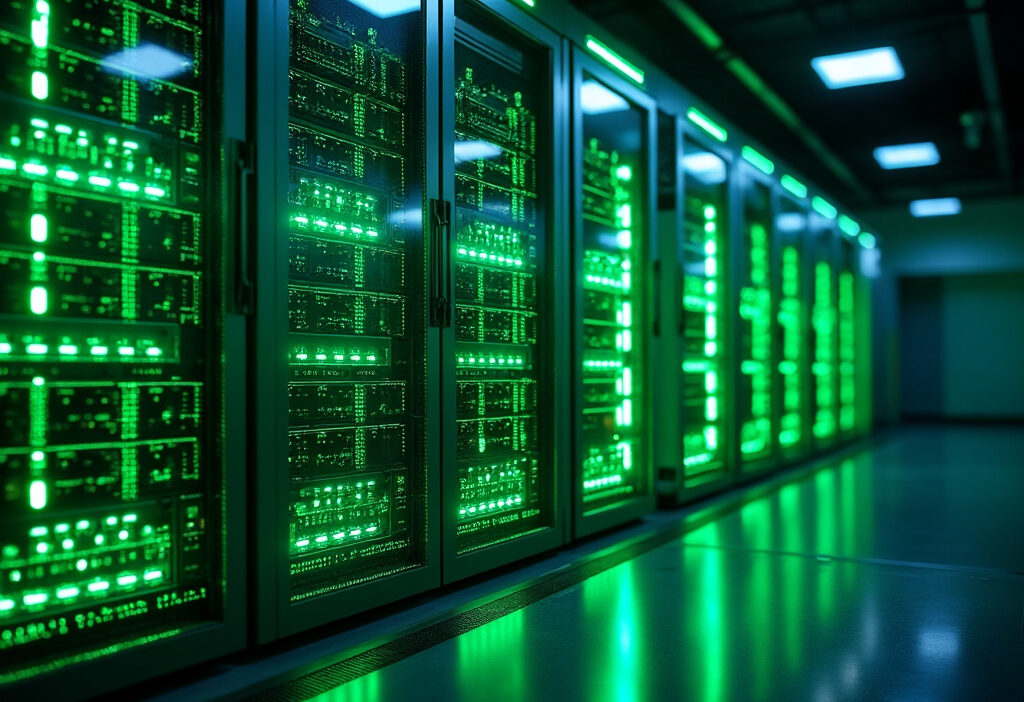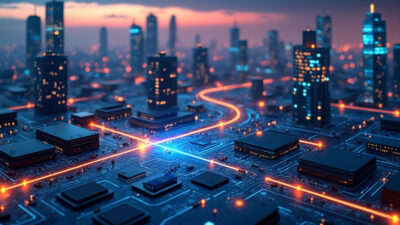Energy-Efficient Computing
In the era of digital transformation, energy-efficient computing emerges as a pivotal innovation, balancing high performance with minimal power consumption. This article delves into the principles, technologies, and benefits of energy-efficient computing, exploring how it revolutionizes industries while contributing to environmental sustainability. From data centers to personal devices, the shift towards efficiency is reshaping our technological landscape.
The Fundamentals of Energy-Efficient Computing
Energy-efficient computing revolves around optimizing the balance between computational performance and power consumption, a concept often quantified as performance per watt. At its core, this principle emphasizes delivering maximum processing capability while minimizing energy expenditure, a critical consideration in an era where data centers, edge devices, and mobile systems demand both high performance and sustainability.
One foundational aspect is dynamic voltage and frequency scaling (DVFS), which adjusts a processor’s operating parameters in real-time based on workload demands. By lowering voltage and clock speed during lighter tasks, DVFS reduces power consumption without sacrificing responsiveness. Similarly, power gating techniques deactivate idle circuit blocks, preventing wasteful leakage currents—a significant source of energy loss in modern chips.
Another key principle is parallelization, where workloads are distributed across multiple cores or specialized accelerators (like GPUs or TPUs) to achieve higher efficiency than single-threaded execution. Parallel architectures often outperform monolithic designs by dividing tasks into smaller, concurrently processed units, reducing the time and energy required for completion.
Energy efficiency also depends on instruction set architecture (ISA) optimizations. Reduced Instruction Set Computing (RISC) designs, such as ARM, prioritize simpler, power-efficient instructions over complex ones, enabling faster execution with lower energy overhead. Meanwhile, advances in near-threshold computing push processors to operate at voltages close to their minimum functional limits, dramatically cutting power while maintaining usability for specific workloads.
The significance of these principles extends beyond hardware—software plays an equally vital role. Efficient algorithms, compiler optimizations, and workload-aware scheduling ensure that systems leverage hardware capabilities without unnecessary energy expenditure. Together, these fundamentals form the backbone of sustainable computing, enabling the next generation of devices to deliver more with less.
Performance Metrics in Energy Efficiency
Measuring the energy efficiency of computing systems requires well-defined metrics that balance performance with power consumption. One of the most widely used benchmarks is FLOPS per watt (floating-point operations per second per watt), which quantifies computational throughput relative to energy expended. This metric is particularly relevant in high-performance computing (HPC) and data centers, where maximizing computational output while minimizing energy waste is critical. Another key metric is performance per watt, a broader measure that can apply to general-purpose processors, GPUs, and specialized accelerators like TPUs.
Beyond raw computational efficiency, energy-delay product (EDP) combines execution time and energy consumption, providing a holistic view of system efficiency. EDP is especially useful in latency-sensitive applications, where both speed and power matter. For mobile and edge devices, energy per task is often prioritized, ensuring that battery life is optimized for specific workloads.
Real-world evaluations also rely on standardized benchmarks like SPECpower for servers, which measures performance across varying power states, and JouleSort, which assesses energy efficiency in data processing tasks. These benchmarks help compare systems under controlled conditions, ensuring fair assessments.
In practice, these metrics guide hardware design, software optimization, and procurement decisions. For example, data centers use Power Usage Effectiveness (PUE) to evaluate overall facility efficiency, while chip manufacturers leverage thermal design power (TDP) to balance performance and heat dissipation. By applying these metrics, organizations can identify inefficiencies, optimize workloads, and reduce operational costs—paving the way for sustainable computing ecosystems.
The next chapter will delve into the technologies that enable these efficiency gains, from advanced processors to intelligent cooling solutions.
Technologies Driving Energy Efficiency
Energy-efficient computing relies on a combination of hardware and software innovations designed to minimize power consumption while maintaining performance. At the hardware level, processors play a pivotal role. Modern CPUs and GPUs leverage architectures like ARM’s big.LITTLE and Intel’s Hybrid Core, which dynamically switch between high-performance and low-power cores based on workload demands. Additionally, specialized accelerators, such as TPUs and FPGAs, optimize energy use by offloading compute-intensive tasks from general-purpose processors.
Cooling systems are another critical component. Traditional air cooling is being replaced by advanced solutions like liquid immersion cooling, which dissipates heat more efficiently, reducing energy overhead. Innovations in phase-change materials and thermoelectric cooling further enhance thermal management, allowing systems to operate at lower temperatures with minimal energy expenditure.
On the software side, energy-aware algorithms and scheduling techniques optimize resource allocation. For instance, dynamic voltage and frequency scaling (DVFS) adjusts processor speed in real-time, balancing performance and power consumption. Machine learning models are also being trained to predict workloads and allocate resources proactively, minimizing idle power waste.
Memory efficiency is another frontier. Non-volatile memory technologies like 3D XPoint and MRAM reduce leakage currents, while software techniques like data compression and caching strategies lower the energy cost of data retrieval.
Together, these technologies create a holistic approach to energy-efficient computing, ensuring that systems meet performance metrics like FLOPS per watt while paving the way for sustainable large-scale deployments, such as those in data centers. The next chapter will explore how these innovations translate into real-world applications in high-density computing environments.
Energy-Efficient Computing in Data Centers
Data centers are the backbone of the digital economy, consuming vast amounts of energy to power servers, storage, and networking equipment. Energy-efficient computing in these facilities is critical to reducing both operational costs and environmental impact. Unlike general-purpose hardware discussed earlier, data centers require specialized optimizations to balance performance with sustainability.
One key innovation is the use of dynamic voltage and frequency scaling (DVFS), which adjusts processor power based on workload demands. By lowering voltage during idle periods, data centers can significantly cut energy waste. Another breakthrough is liquid cooling systems, which replace traditional air cooling with more efficient heat dissipation methods, reducing the energy needed for temperature control.
Virtualization and containerization also play a crucial role. By consolidating multiple workloads onto fewer physical servers, these technologies maximize hardware utilization, minimizing the number of active machines. Additionally, AI-driven workload scheduling optimizes resource allocation, ensuring tasks run on the most energy-efficient hardware available.
Renewable energy integration is another growing trend. Many data centers now pair energy-efficient hardware with solar or wind power, further shrinking their carbon footprint. Google and Microsoft, for example, have committed to 24/7 carbon-free energy for their data centers, combining hardware efficiency with clean power sources.
Finally, advancements in low-power memory and storage, such as non-volatile memory express (NVMe) and 3D NAND flash, reduce energy consumption without sacrificing speed. These innovations ensure that data centers meet rising computational demands while staying sustainable.
As the next chapter will explore, similar principles of energy efficiency are transforming consumer electronics, proving that optimized computing benefits both large-scale infrastructure and everyday devices.
The Impact on Consumer Electronics
Energy-efficient computing has revolutionized consumer electronics, enabling devices like smartphones, laptops, and wearables to deliver superior performance while minimizing power consumption. Unlike data centers, where efficiency focuses on large-scale infrastructure, consumer devices prioritize on-chip optimizations and intelligent power management to extend battery life and reduce heat generation.
Modern processors, such as ARM-based chips in smartphones, leverage big.LITTLE architectures, combining high-performance and low-power cores to dynamically balance workloads. This ensures tasks like gaming or video streaming use only the necessary resources, while background processes run efficiently. Similarly, advancements in FinFET transistor technology have reduced leakage currents, allowing chips to operate at lower voltages without sacrificing speed.
Software plays an equally critical role. Operating systems now integrate adaptive brightness, app throttling, and deep sleep modes to curb unnecessary energy drain. For example, Apple’s iOS and Google’s Android use machine learning to predict user behavior, optimizing battery usage by delaying non-critical updates until charging.
The benefits extend beyond longevity. Lower power consumption reduces thermal output, enabling thinner, lighter designs without compromising performance. Devices like the MacBook Air with Apple’s M-series chips demonstrate how efficiency translates into all-day battery life and silent operation—key selling points for consumers.
Moreover, energy-efficient computing aligns with sustainability goals, as longer-lasting devices decrease electronic waste. By minimizing energy demands, manufacturers also reduce reliance on fossil-fueled grids, indirectly lowering carbon emissions—a theme further explored in the next chapter on Green Computing.
In summary, energy-efficient computing in consumer electronics is a synergy of hardware innovation and software intelligence, delivering tangible user benefits while supporting broader environmental objectives.
Green Computing and Environmental Benefits
Energy-efficient computing plays a pivotal role in mitigating the environmental impact of technology, offering substantial benefits in reducing carbon emissions and promoting sustainable practices. As computing devices become more pervasive, their collective energy consumption and associated greenhouse gas emissions have surged. By optimizing energy use, green computing minimizes these effects, aligning technological progress with ecological responsibility.
One of the most significant environmental advantages is the reduction in carbon footprints. Data centers, which power cloud services and enterprise operations, account for nearly 1% of global electricity demand. Energy-efficient hardware, such as low-power processors and advanced cooling systems, can cut energy consumption by up to 40%, directly lowering CO2 emissions. Similarly, software optimizations—like dynamic voltage scaling and workload consolidation—further enhance efficiency without compromising performance.
Beyond carbon reduction, energy-efficient computing fosters sustainable resource management. Traditional computing relies heavily on non-renewable energy sources, but green computing encourages the adoption of renewable energy, such as solar or wind-powered data centers. Additionally, extended device lifespans—enabled by efficient thermal management and power-aware designs—reduce electronic waste, a growing environmental concern.
The shift toward energy efficiency also drives industry-wide sustainability initiatives. Governments and organizations are implementing stricter energy standards, like the ENERGY STAR certification, pushing manufacturers to innovate. Furthermore, the circular economy model gains traction, emphasizing recyclability and responsible disposal of tech components.
While the benefits are clear, achieving widespread adoption remains challenging, as explored in the next chapter. However, the environmental advantages of energy-efficient computing underscore its necessity in building a sustainable digital future.
Challenges in Achieving Energy Efficiency
Despite the clear environmental benefits of energy-efficient computing, achieving widespread adoption is fraught with challenges. One of the most significant barriers is cost. Developing and deploying energy-efficient hardware, such as low-power processors and advanced cooling systems, often requires substantial upfront investment. While these technologies promise long-term savings, the initial expense can deter organizations, especially smaller enterprises, from making the switch. Additionally, retrofitting existing infrastructure to support energy-efficient systems can be prohibitively expensive, slowing down the transition.
Another major hurdle is technology limitations. While advancements like quantum computing and neuromorphic chips hold promise, they are still in nascent stages and face scalability issues. Current semiconductor technologies are approaching physical limits, making it increasingly difficult to reduce power consumption without sacrificing performance. Thermal management remains a critical challenge, as higher densities of transistors generate more heat, requiring innovative cooling solutions that themselves consume energy.
Scalability further complicates the picture. Energy-efficient solutions that work in controlled environments or small-scale deployments often struggle when applied to large data centers or global cloud infrastructures. Variability in workloads and the need for real-time processing can undermine efficiency gains, as systems must remain operational even during peak demand. Moreover, the lack of standardized metrics for measuring energy efficiency makes it difficult to compare solutions and incentivize improvements across the industry.
Finally, there’s the challenge of behavioral and organizational resistance. Many institutions prioritize short-term performance over long-term sustainability, perpetuating reliance on legacy systems. Without stronger regulatory frameworks or economic incentives, the shift toward energy-efficient computing may remain sluggish, delaying the full realization of its environmental potential.
Future Trends in Energy-Efficient Computing
The future of energy-efficient computing is poised for transformative breakthroughs, driven by the convergence of novel materials, advanced architectures, and intelligent algorithms. One of the most promising advancements lies in neuromorphic computing, which mimics the human brain’s energy-efficient processing. By leveraging spiking neural networks, these systems can drastically reduce power consumption while handling complex tasks like real-time AI inference. Companies like Intel and IBM are already prototyping chips that consume fractions of the energy of traditional processors for equivalent workloads.
Another frontier is the development of 2D materials, such as graphene and transition metal dichalcogenides, which promise ultra-low-power transistors with near-zero leakage currents. These materials could enable next-generation chips that operate at voltages as low as 0.1V, a significant drop from today’s 0.7V thresholds. Combined with 3D chip stacking, where layers of processors and memory are vertically integrated, these innovations could reduce energy waste from data movement—a major inefficiency in current systems.
Quantum computing, though still in its infancy, may also contribute to energy efficiency by solving optimization problems that currently require massive computational resources. Hybrid quantum-classical systems could offload energy-intensive tasks to quantum processors, leaving conventional hardware for less demanding operations.
On the software side, adaptive machine learning models are being designed to dynamically adjust their computational load based on real-time energy availability. Techniques like pruning and quantization are making AI models leaner without sacrificing accuracy. Meanwhile, edge computing is decentralizing processing power, reducing the energy burden of data centers by bringing computation closer to the source of data.
These advancements, coupled with policy-driven energy standards, will redefine the boundaries of sustainable computing, addressing the challenges outlined earlier while setting the stage for real-world implementations discussed in the next chapter.
Case Studies of Energy-Efficient Systems
Energy-efficient computing has already seen remarkable success in real-world applications, with several high-profile systems demonstrating how optimized power usage can lead to sustainable yet high-performance operations. One standout example is Fugaku, the world’s fastest supercomputer in 2020, developed by RIKEN and Fujitsu. Fugaku leverages ARM-based processors with a highly efficient architecture, consuming significantly less power per operation compared to traditional x86-based supercomputers. Its design prioritizes performance-per-watt, achieving 442 petaflops while maintaining energy efficiency—a critical benchmark for future exascale systems.
Another compelling case is Google’s data centers, which employ advanced machine learning to optimize cooling and power distribution. By using AI-driven predictive algorithms, Google reduced its cooling energy consumption by 40%. Their custom Tensor Processing Units (TPUs) also contribute to efficiency, as they are tailored for AI workloads, minimizing redundant computations and energy waste.
In cloud computing, Microsoft’s underwater data center project, Natick, showcases an innovative approach. By submerging servers in sealed pods off the coast of Scotland, Microsoft leverages natural seawater cooling, drastically cutting energy use for temperature regulation. Early results indicate a 40% improvement in efficiency compared to land-based counterparts.
Additionally, Apple’s M-series chips redefine efficiency in consumer devices. Built on a 5nm process, these chips deliver desktop-class performance in laptops while consuming a fraction of the power of traditional CPUs. Their unified memory architecture and optimized instruction sets reduce energy waste, proving that efficiency can coexist with high performance.
These case studies highlight that energy-efficient computing is not just theoretical—it’s already transforming industries. From supercomputers to consumer tech, optimized designs and intelligent management systems are setting new standards for sustainability without compromising power. The next chapter will explore how businesses can implement similar strategies to achieve their own energy efficiency goals.
Implementing Energy Efficiency in Your Organization
Implementing energy-efficient computing practices in your organization doesn’t require a complete overhaul—small, strategic changes can yield significant savings. Start by auditing your current energy usage to identify inefficiencies. Tools like SPECpower or Intel’s Power Gadget can help measure power consumption at the hardware level, while cloud-based solutions like Google Cloud Carbon Footprint provide insights into data center efficiency.
Optimize hardware utilization by consolidating workloads. Virtualization technologies, such as VMware or Hyper-V, allow multiple applications to run on a single server, reducing idle power consumption. For businesses relying on physical machines, upgrading to Energy Star-certified or 80 PLUS-rated power supplies ensures higher efficiency. Additionally, adopting low-power processors, like ARM-based chips or Intel’s Efficient-core (E-core) designs, can cut energy use without sacrificing performance.
Software optimization is equally critical. Use energy-aware programming practices, such as minimizing background processes and optimizing algorithms for reduced computational load. Tools like Green Software Foundation’s Carbon Aware SDK help developers build applications that adjust workloads based on renewable energy availability.
For cloud-based operations, leverage auto-scaling and serverless architectures to dynamically allocate resources, avoiding over-provisioning. Providers like AWS and Azure offer carbon footprint dashboards to track emissions, enabling smarter workload scheduling.
Finally, foster a culture of energy awareness among employees. Simple actions—like enabling sleep modes on idle devices, using dark mode interfaces, and powering down unused equipment—can collectively make a difference. By integrating these strategies, organizations can reduce costs, meet sustainability goals, and contribute to a greener tech ecosystem.

Conclusions
Energy-efficient computing stands at the forefront of technological innovation, offering a path to sustainable growth. By embracing efficiency, we not only enhance performance but also contribute to a greener planet. This article has explored the multifaceted aspects of energy-efficient computing, from its foundational principles to its real-world applications, underscoring its critical role in shaping the future of technology.



